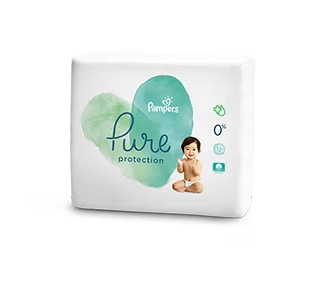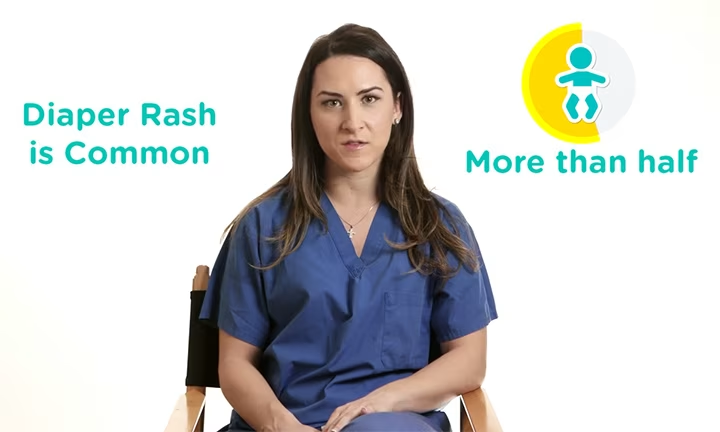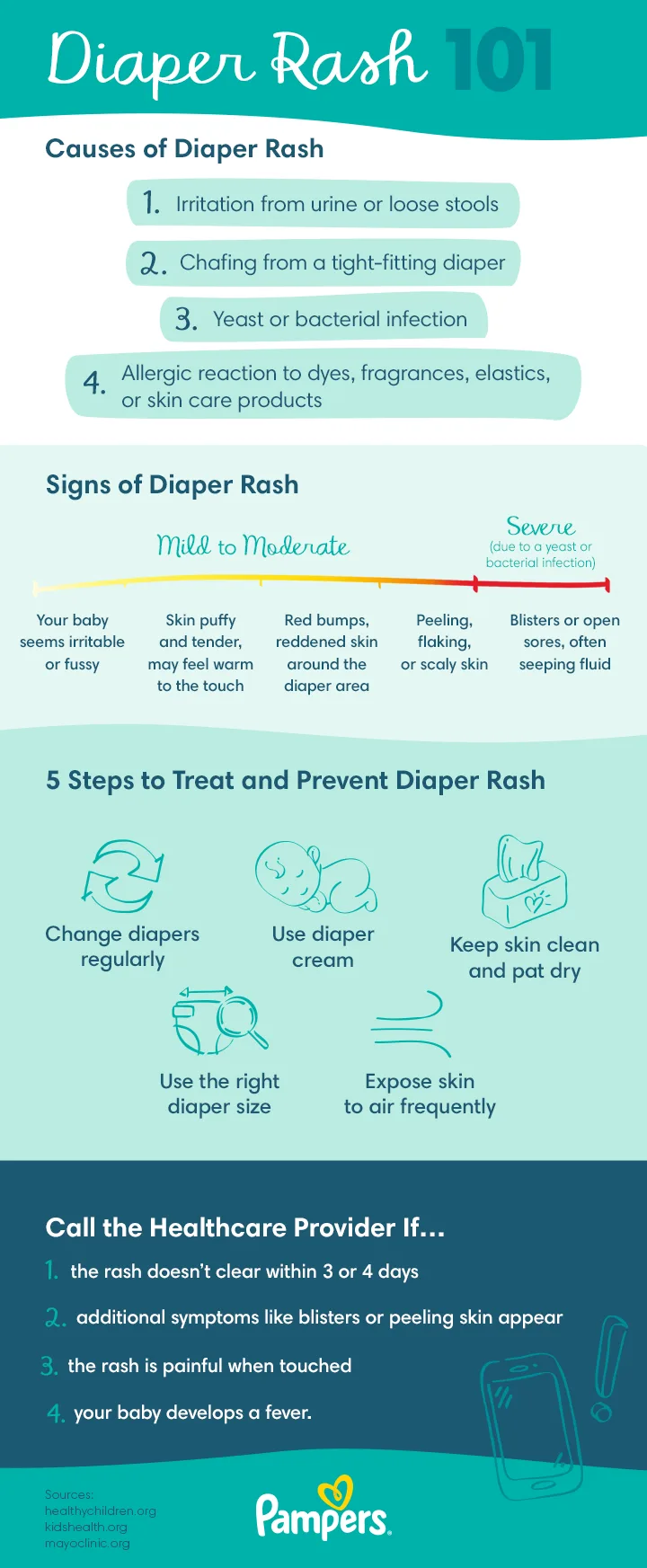Diaper Rash 101
Most babies will have diaper rash at least once, even with superabsorbent diaper technology and frequent diaper changes. In most cases, mild diaper rash will clear up in a few days with simple treatment, and your baby’s skin will be back to normal. Find out more about what causes diaper rash, what the symptoms are, and how you can treat this condition as quickly as possible and prevent it from reoccurring.
What Is Diaper Rash?
Diaper rash is a common condition that typically forms when the sensitive skin around your baby’s diaper area is in contact with urine or stool for too long. Diaper rash can make your baby’s skin red, very tender, and flaky. With proper treatment, it will usually clear up within three or four days. However, if the diaper rash doesn’t noticeably improve within a couple of days, or, if it gets worse, call your baby’s healthcare provider for guidance. Protecting your baby against diaper rash means regularly changing his diapers. Fortunately, you can turn all those diaper into rewards and deals. Download the Pampers Club app to get access to special offers.
In Summary Diaper rash is quite common, and can happen to any baby, including a newborn. The skin condition can make your baby’s diaper area red, tender, and flaky. Changing your baby’s diaper regularly and immediately after it’s soiled can help prevent diaper rash. If your baby’s diaper rash persists, consult her healthcare provider. |
Diaper Rash Causes
Even with frequent diaper changes, diaper rash can still happen. In the next sections we describe some of the causes of diaper rash and situations in which it might occur.
Diaper Rash Caused by Irritants
The most common cause of diaper rash is skin irritation resulting from
prolonged exposure to urine or stool
a bout of diarrhea, which can bring the skin in contact with loose stools
teething, which leads to increased saliva product and swallowing lots of saliva, which may affect the stool, resulting in diaper rash
a tight-fitting diaper or tight clothing that causes chafing or rubbing.
What to look for: Pink or red patches in the diaper area. The folds of the groin will usually look normal. What to do about it: Make sure to change your baby’s diaper regularly, keep the diaper area clean, and apply a diaper cream. It’s also a good idea to use a highly absorbent diaper and to make sure that it isn’t too tight and doesn't chafe.
Yeast Infection Diaper Rash in Babies
Another common cause of diaper rash is a yeast infection, resulting from an overgrowth of fungus located in the digestive tract. In some instances, the same fungus that causes oral thrush, candida, may be responsible for your baby’s diaper rash. This type of yeast infection can occur if your baby has a weakened immune system, which can lead to an overgrowth of the candida fungus. A yeast infection can sometimes develop after your baby’s completed a course of antibiotics or if you’ve taken antibiotics while breastfeeding. Antibiotics don’t differentiate between good and bad bacteria, killing both kinds, and this can lead to a yeast infection or cause diarrhea, which irritates the diaper area. What to look for: Shiny, bright red patches with sharp edges. There may even be pink bumps or pimples, sores, or cracked skin that’s oozing or bleeding. A fungal diaper rash is often more severe when it appears in the folds of your baby’s groin, and this is another indication that it may not be your standard diaper rash. What to do about it: If you suspect this kind of diaper rash, contact your baby’s healthcare provider, who may prescribe a topical antifungal cream. Be sure to wash your hands before and after any diaper change to prevent the spread of the fungus.
Bacterial Diaper Rash in Babies
Although cases are rare, diaper rash can be due to a bacterial infection called impetigo, caused by either the staph or strep bacteria. This can lead to diaper rash or make an existing diaper rash worse. What to look for: A strep infection will often show up as bright red skin around your baby’s anus, whereas a staph infection may appear as yellow crusting, weeping, or pimples. What to do about it: If you believe your baby’s diaper rash may be due to a bacterial infection, see your baby’s healthcare provider for diagnosis and treatment. Don’t use an over-the-counter antibiotic ointment to treat the diaper rash, unless it’s recommended by your child’s provider.
Diaper Rash Caused by Allergens
Your baby may be sensitive or allergic to certain substances or ingredients, such as
dyes in soap or laundry detergent
the elastic in diapers
fragrances in soap, laundry detergent, fabric softeners, or diaper wipes
preservatives in ointments and creams
ingredients found in baby powder, lotions, and oils
food—allergens can be passed on to your baby through breast milk, or through any solid foods your baby eats once he's started on solids.
What to look for: A rash may show up shortly after exposure to the allergen. What to do about it: Consider switching to another type of diaper, wipe, or cream for a two-week period to see if that helps clear up the rash. If a food allergy is suspected, remove that food from your baby’s diet. See your baby’s healthcare provider for diagnosis, possible testing, and treatment recommendations.
Other Causes of Diaper Rash
There are some other conditions that can look a little like diaper rash. For example, the rash may actually be seborrheic dermatitis, a condition in which the glands of the skin produce too much oil. Or, the rash may be triggered by a genetic condition like acrodermatitis enteropathica, which is a zinc deficiency. If you believe your baby’s diaper rash may be due to one of these conditions, or if you’re not sure what’s causing the rash, see your little one’s healthcare provider for a proper diagnosis and appropriate treatment.
In Summary There are many different potential causes of diaper rash including irritants, allergens, and infections caused by bacteria or yeast. In some rare cases, a rash in the diaper area may be caused by a genetic condition. Your child’s healthcare provider will be able to make an expert diagnosis. |
What Does Diaper Rash Look Like?
Common signs of diaper rash include:
Red bumps along with larger reddened areas of the skin around the diaper area or in the folds of your baby’s upper thighs
Peeling, flaking, or scaly skin
The affected area may look puffy and tender, and feel warm to the touch
Your baby seems irritable or fussy.
If the rash comes from a skin infection caused by yeast or bacteria, for example, then you might see more severe diaper rash signs, such as
Blisters or open sores
Pus-filled blisters
Watery fluid or pus seeping from reddened patches.
In Summary Diaper rash looks red and can have bumps, as well as peeling, flaking, or scaling skin. An especially bad form of diaper rash caused by either a fungal or bacterial infection may have pus-filled blisters or sores. |
Diaper Rash Treatment and Prevention
The steps for treating diaper rash and preventing it are very similar, so if you want to know how to get rid of diaper rash as well as how to help prevent it from reoccurring in the future, follow these guidelines:
Change your baby’s diaper regularly. When your baby has a wet or dirty diaper, change it promptly. Moisture from a dirty diaper can quickly lead to diaper rash, as urine contains irritants, as do the digestive enzymes in stool. This simple solution is the best way to clear or prevent diaper rash.
Use diaper cream. Apply a thick layer—like frosting a cake—of diaper rash cream or ointment that contains petroleum jelly or zinc oxide. It will keep your baby’s delicate skin protected by forming a barrier against moisture. Look for a fragrance-free variety. Some top diaper rash creams are formulated with organic and natural ingredients, in case you prefer that. Ask your baby’s healthcare provider if you’re unsure which diaper cream is best for your little one.
Keep your baby’s skin clean. Use wipes that are free of alcohol and fragrance. Or, you can clean your baby’s skin with water and a non-soap/gentle cleanser, which can be less irritating if your baby already has diaper rash. Use a squirt or spray bottle on a severe diaper rash and try not to rub the rash. Gently pat the skin dry and allow it to air-dry. Apply a thick layer of barrier paste on the diaper area before putting on a fresh diaper.
Choose the right size of diaper. Make sure that your baby’s diaper fits properly. A diaper that’s too tight, especially at night, blocks airflow and can also lead to a diaper rash caused by chafing. Consider using a slightly larger diaper while your baby is recovering from diaper rash.
Let your baby go commando. When you can, let your baby go without a diaper. For example, you could spread out a clean towel on the floor during playtime or tummy time and keep your baby’s diaper off for a while. Exposing their skin to the air helps eliminate excess moisture and reduces the time spent in close contact with diapers, if that’s the cause of the irritation.
See our Diaper Rash 101 below for an overview of the symptoms, causes, and treatments for diaper rash:
When to See Your Baby’s Healthcare Provider
If your baby exhibits any of the following, you may need to see their provider:
The diaper rash doesn’t seem to go away, or worsens after two to three days of treatment
In addition to the diaper rash, there are also pimples, blisters, peeling skin, or pus-filled sores that are oozing or crusty
Your baby is on antibiotics and develops a rash that’s bright pink or red with red spots around the edges
The rash is very painful when you touch it
In addition to the rash, your baby develops a fever.
What Your Baby’s Provider Might Recommend
If the diaper rash doesn’t clear up or if it worsens, your baby’s healthcare provider might prescribe a special ointment or cream such as
a mild steroid or hydrocortisone cream
an antifungal cream, if your baby’s provider diagnoses a fungal infection
oral antibiotics or an antibiotic cream that’s applied directly to your baby’s skin, if your baby is diagnosed with a bacterial infection.
Home Remedies for Diaper Rash
Home remedies for diaper rash that have been shown in some studies to work for some babies include applying one of the following on your baby’s diaper rash:
Witch hazel
Your breast milk
Aloe vera
Calendula.
Consult with your baby’s healthcare provider first if you’re interested in trying a home remedy.
In Summary The first line of defense against diaper rash is changing your baby’s diaper immediately after it’s been soiled; then, use diaper rash cream to create a protective barrier between your baby’s diaper area and the urine or stool. Keep your baby’s skin clean. Use absorbent diapers to ensure moisture is wicked away, and let your baby go without diapers when you can. If these measures don’t seem to work, your baby’s healthcare provider can give you a personalized treatment plan. |
FAQS AT A GLANCE
Most mild cases of diaper rash will clear up within a few days with
- frequent diaper changes
- air-drying of the skin
- use of a diaper rash cream.
The Bottom Line
There are many different types of diaper rashes, each with a different recommended treatment. As a parent, you can do your best to both treat and prevent diaper rash by following the tips above, including frequently changing your baby’s diaper and keeping the skin clean and protected with diaper rash cream. Some of these strategies and treatments are important not only for helping to ward off diaper rash but for the overall care of your little one’s skin. If these measure don’t resolve the diaper rash, your baby’s healthcare provider will be able to recommend appropriate treatment. It may be that your little one has diaper rash caused by a yeast infection or bacteria, which will require a specific ointment or medication. Even when you’re careful to frequently change your little one’s diapers, it’s likely that they’ll get a diaper rash at some point. The good news is that most mild cases clear up within a few days with simple treatment, and your baby’s skin will again be, well, as smooth as a baby’s bottom!
Related diapering tool
Diaper Size Calculator
Find out your baby's diaper size, how many diapers you'll need per day and for how long:
The information in this article is based on the expert advice found in trusted medical and government sources, such as the American Academy of Pediatrics and the American College of Obstetricians and Gynecologists. You can find a full list of sources used for this article below. The content on this page should not replace professional medical advice. Always consult medical professionals for full diagnosis and treatment.
Read more about About Pampers
Join Pampers Club and get:






